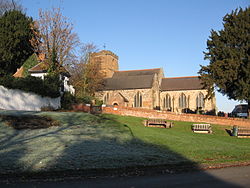Mancetter
| Mancetter | |
| Warwickshire | |
|---|---|
 St Peter's parish church | |
| Location | |
| Grid reference: | SP3296 |
| Location: | 52°34’8"N, 1°31’44"W |
| Data | |
| Population: | 2,449 (2001[1]) |
| Post town: | Atherstone |
| Postcode: | CV9 |
| Dialling code: | 01827 |
| Local Government | |
| Council: | North Warwickshire |
| Parliamentary constituency: |
North Warwickshire |
| Website: | Welcome to Mancetter Parish |
Mancetter is a village and parish in the Hemlingford hundred of Warwickshire, on the south-eastern outskirts of Atherstone. The village lies at the crossing of Watling Street over the River Anker. The population (including Gopsall, Leicestershire) had reduced from 2,447 to 2,339 at the 2011 census.[2]
History
During the Roman occupation of Britain a posting station was first built athwart Watling Street close to the river crossing, and a rectangular earthwork of this station is still extant.[3] The much larger legionary fortress of the Legio XIV Gemina was built here by about AD 50, before the legion moved to Wroxeter in about AD 55.[4]
Around the fortress grew the settlement of Manduessedum.[3] It is thought that Mancetter is the most likely location of the Battle of Watling Street, between an alliance of indigenous British peoples led by Boudica and a Roman army led by Gaius Suetonius Paulinus, although the exact location is unknown.
Mancetter does not appear in the Domesday Book of 1086 but in 1196 a Walter de Mancetter granted land to endow the parish church.[3] The chancel walls of the Church of England parish church of Saint Peter still include 12th-century masonry.[3] The chancel and nave]were remodelled early in the 13th century and the north aisle was added later in the 13th century.[3] The bell tower, the south aisle and the clerestorey of the nave all seem to have been added in the 15th century.[3] The south porch was added early in the 17th century.[3] Restoration work was carried out in 1876, 1911 and 1930,[3] and the Gothic Revival architect C.C. Rolfe may have undertaken restoration work in 1899.[5] The tower has a peal of five bells, of which the oldest was cast about 1350, another early in the 16th century and the treble, tenor and third bell in the middle of the 17th century.[3]
The advowson of St Peter's was impropriated by the Cistercian Abbey of Merevale in 1449.[3]
Mancetter Manor House is a timber-framed building dating from about 1330.[3] An intermediate floor was inserted in the great hall in about 1480 and the south wing was added in about 1580.[3] The central chinmeystack was probably inserted in the 17th century and small extensions to the house were made in the 18th and 19th centuries.[3]
Etymology
The modern name Mancetter is a reduced form of an old Celtic name Manduessedum, first recorded in the Antonine Itinerary in the 4th Century.[6] It is composed of a British element *mandu – ‘horse’ or ‘pony’ and a Gaulish *essedo - ‘horse chariot’.[7] Although the first element is common in Gaulish names, the application of the second element to a place-name is obscure. The second element of the modern name is the OE ceaster – ‘a city, an old fortification, Roman site’.
References
- ↑ "Area: Mancetter CP (Parish): Parish Headcounts". Neighbourhood Statistics. Office for National Statistics. http://neighbourhood.statistics.gov.uk/dissemination/LeadTableView.do?a=7&b=800166&c=Mancetter&d=16&e=15&g=493120&i=1001x1003x1004&o=1&m=0&r=1&s=1271808346915&enc=1&dsFamilyId=779. Retrieved 21 April 2010.
- ↑ "Civil Parish population 2011". http://www.neighbourhood.statistics.gov.uk/dissemination/LeadKeyFigures.do?a=7&b=11126272&c=Mancetter&d=16&e=62&g=6471206&i=1001x1003x1032x1004&m=0&r=1&s=1451471608547&enc=1. Retrieved 30 December 2015.
- ↑ 3.00 3.01 3.02 3.03 3.04 3.05 3.06 3.07 3.08 3.09 3.10 3.11 3.12 Salzman, 1947, pages 116-126
- ↑ Rome Against Caractacus, G. Webster. ISBN 0713472545, P 49
- ↑ Saint, 1970
- ↑ Gover, et al., pages 85-86
- ↑ Rivet and Smith, pages 411-412
Sources
- Gover, J.E.B.; Mawer, A.; Stenton, F. (1936). The Place-names of Warwickshire. The English Place-name Society. pp. 85–86. ISBN 0 521049 06 7.
- Pevsner, Nikolaus; Wedgwood, Alexandra (1966). The Buildings of England: Warwickshire. Harmondsworth: Penguin Books. pp. 346–347. ISBN 0 14 071031 0.
- Rivet, A.L.E.; Smith, C. (1981). The Place-names of Roman Britain. (2nd ed.). London: Batsford. pp. 411–412. ISBN 0 7134 2077 4.
- Saint, Andrew (1970). "Three Oxford Architects". Oxoniensia (Oxfordshire Architectural and Historical Society) XXXV: 53 ff. http://www.oahs.org.uk/oxo/vol%2035/Saint.doc. Retrieved 3 November 2009.
- Salzman, L.F., ed (1947). Victoria County History: A History of the County of Warwick, Volume 4. pp. 116–126.
Outside links
| ("Wikimedia Commons" has material about Mancetter) |
- Atherstone-forum Mancetter and Athersone online forums
- List of volumes Survey of English Place-names
- Key to English Place-names